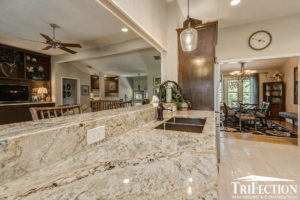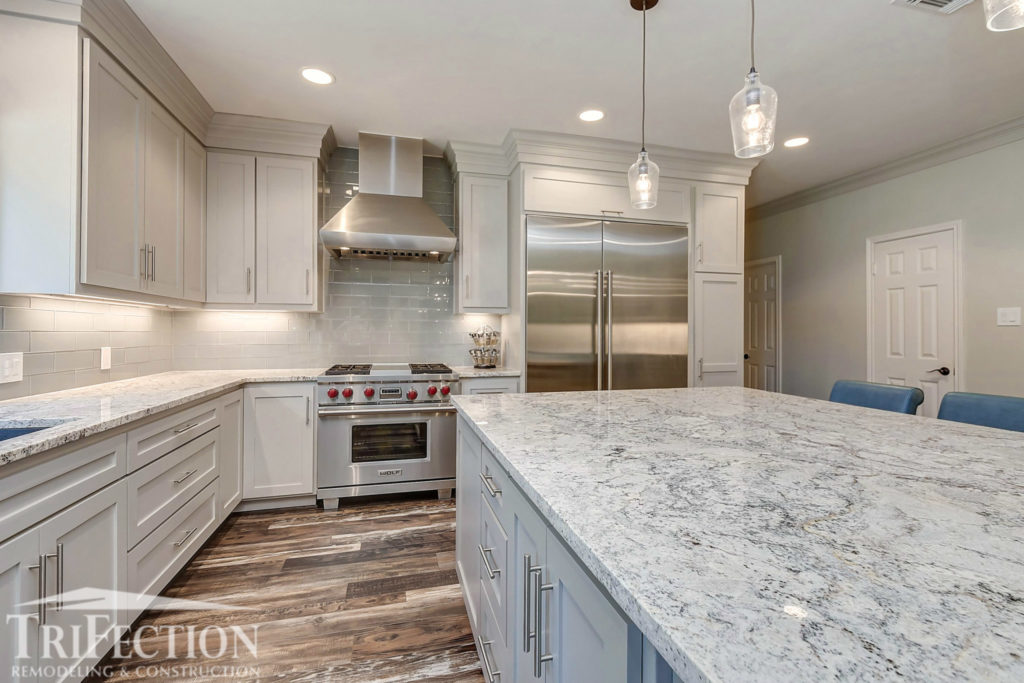Do you know the differences between granite grades?
Whether you’re remodeling your kitchen or your bathroom, granite countertops can complement any design style. The heat and chip resistant material can last for decades, making the decision to upgrade to granite a fairly simple one. However, with the many options available, the choice between granite material can be a little more difficult than many homeowners believe.
Choosing a granite option that fits your personal style is certainly the top priority. But, not all granite is created equally. Variances exist across the quality of the material itself, the fabrication, and even the installation. Like diamonds, granite has different tiers of quality. We call these tiers “granite grades”.
In this post, our home design and selection experts at TriFection will tackle a few frequently asked questions about granite grades, including how they are determined and what they mean.
How Do You Determine The Granite Grade?
A granite’s “grade” refers to the structural quality of the stone.
Three levels of granite exist: Level 1, Level 2, and Level 3+. Level 1 is “low-grade” granite, while Level 3+ is “high-grade”.
A dealer looks at several identifiers when assigning a granite grade to a slab of granite.  The granite’s richness and scarcity of color oftentimes can provide a good indication of the granite quality. Highly unique and uncommon veining and colors will get a higher grade than other slabs.
The granite’s richness and scarcity of color oftentimes can provide a good indication of the granite quality. Highly unique and uncommon veining and colors will get a higher grade than other slabs.
Apart from the color, pattern and veining, the pitting, marking, thickness, as well as the amount of soft materials in the granite contribute to its grade.
Contrary to popular belief, there isn’t an industry standard for granite grading. Most suppliers have an in-house system for grading, and although similar systems are in place, there will be some discrepancy between vendors. So what’s Level 2 for one wholesaler maybe Level 1 for another. For this reason, you should always make sure to source granite from a reputable and knowledgeable wholesaler or installer, such as TriFection.
Let’s break down the different aspects of granite grading:
Visual Appearance of the Granite
One of the biggest hallmarks of quality for a slab of granite is simply how it looks. Unique colors and patterns will earn a higher grade than more standard appearances.
Higher quality granite is also less likely to have flaws, pits, cracks, and other imperfections. Make sure to examine a slab of granite closely before you buy it. Even the smallest crack can become an issue later on.
Granite Origins
Granite is a natural stone and comes from all over the world. Origin doesn’t necessarily dictate quality, but it can have a significant effect on the cost.
For instance, like many products from China, granite from that region may come at a lower resale cost because of lower labor costs.  It follows that granite from Italy or Brazil will be a little more expensive.
It follows that granite from Italy or Brazil will be a little more expensive.
Granite is also pretty expensive to ship, due to its size and weight. If you buy granite here in the US, you won’t pay as much in shipping as if you buy granite from Italy.
Granite Thickness
Granite comes out of the Earth in massive slabs. To make these huge slabs more manageable, manufacturers will cut them into thinner slabs. When you cut the granite into a thinner slice, it reduces the durability of the slab.
Thick granite is stronger, and thus, of higher quality.
Granite Porosity
Each slab of granite will vary in its makeup. Each slab will contain hard and soft materials. One piece of granite may be more absorbent than another. We call this quality the granite’s “porosity”.
The more porous a piece of granite is, the more sealant it will need. If you have a particularly porous piece of granite, it will need frequent coats of sealant to survive.
When you work with TriFection, our selections team will help you choose a high-quality piece of granite. But, if you’re curious about a granite’s porosity, there’s a little test you can perform: Squeeze a drop of lemon juice onto your granite countertop. Watch it to determine how long it takes to absorb. If it takes a long time, or if it doesn’t absorb at all, your granite is not very porous. If it absorbs immediately, that granite is highly porous.
What’s The Difference Between Granite Grades?
We briefly touched on superficial differences between granite options already. To summarize, higher quality granite will feature fewer imperfections, more thickness and durability, and more unique and attractive colors.
Now, we’ll go over each granite grade, and what it means in terms of quality:
Level 1: Entry-Level Granite
Level 1 granite, or “entry-level” granite, is the lowest grade of granite. We also sometimes call it “builder-grade” or “commercial-grade”.
This lower level of granite usually goes through a pre-fabrication process, meaning it’s fabricated prior to a known usage. In contrast, custom-fabricated granite is cut and polished to the exact specifications required for the intended usage. Wholesalers often sell pre-fab material cheap for apartments, furniture, or pre-fab remodels.
The cut of this granite is usually pretty thin, less than 1/2″ thick. The colors and movement for this granite grade will be fairly basic.
Level 2: Mid-Grade Granite
Level 2 grade granite will usually have a thickness of about ¾” thick. The designs and colors will be a little more unique than a Level 1 granite. Also, the patterns for Level 2 granite will show a little more diversity than those seen on a Level 1 granite slab.
Level 3: High-Grade Granite
At TriFection, we strongly recommend high-quality, custom-fabricated granite slabs to our clients. Most commonly, they choose Level 3+ granite.
Granite with a grade of Level 3+ include some of the most beautiful slabs available. The color and design will be unique.  You very well may see uncommon veining and colors in this higher-quality granite that is truly one-of-a-kind. You won’t discover an identical look in anyone else’s home. Once they see this granite installed, your friends, family, and neighbors will be impressed…and probably at least a little envious!
You very well may see uncommon veining and colors in this higher-quality granite that is truly one-of-a-kind. You won’t discover an identical look in anyone else’s home. Once they see this granite installed, your friends, family, and neighbors will be impressed…and probably at least a little envious!
The thickness of these slabs is usually ¾” inch or more, which provides excellent durability. You won’t have to worry about frequently resealing or your slab chipping or cracking.
What About Granite Fabrication and Installation?
So, how do granite grades affect you and your home renovation?
Well, the grade of granite you choose matters immensely to the quality of your countertops. Lower quality granite won’t last as long and won’t look as nice. Think of your granite countertops as a long-term investment, because in all actuality, they are!
Moreover, the quality of the fabrication and installation work matter just as much as the quality of your chosen slab. Poor fabrication or installation work can ruin the best quality, most gorgeous granite slab in the world. The number and location of seams, or lack thereof, between slabs of granite and the finished edges go a long way in determining the overall appearance of a countertop. More ornate countertop edges require more fabrication work and intensive craftsmanship than the most common bullnose or straight polish edges.
If you want countertops that are beautiful and long-lasting, you need high-quality granite as well as high-quality fabrication and installation.
TriFection Installs Top Quality Granite Grade Material
Fortunately, TriFection can help you with all three criteria. We will guide you to the best granite grades, and we use only the most highly skilled fabricators and installers!
We recognize your home renovation represents a major investment you want to enjoy for many years to come. Therefore, as with all aspects of the project, we recommend only quality granite countertop materials that capture your sense of style and fit your budget. Our team of professionals will assist with all aspects of the remodeling process, from beginning to end. TriFection clients have peace of mind the beauty and functionality of their home upgrades will last a very long time, and we’ll be here for support if they ever need us in the future.
Call TriFection at 281-KITCHEN, or leave us a message on our website!









